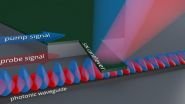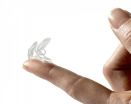(Press-News.org) A team of Tel Aviv University and UCLA astronomers have discovered a remarkable cluster of more than a million young stars are forming in a hot, dusty cloud of molecular gases in a tiny galaxy very near our own.
The star cluster is buried within a massive gas cloud dubbed "Cloud D" in the NGC 5253 dwarf galaxy, and, although it's a billion times brighter than our sun, is barely visible, hidden by its own hot gases and dust. The star cluster contains more than 7,000 massive "O" stars: the most brilliant stars extant, each a million times more luminous than our sun.
"Cloud D is an incredibly efficient star and soot factory," says Prof. Sara Beck of TAU's Department of Astronomy and Astrophysics and co-author of the research, recently published in Nature. "This cloud has created a huge cluster of stars, and the stars have created an unprecedented amount of dust."
For the study, Prof. Beck collaborated with Prof. Jean Turner, Chair of UCLA's Department of Physics and Astronomy, and a team of researchers at the Submillimeter Array, a joint project of the Smithsonian Astrophysical Observatory and the Academia Sinica Institute of Astronomy and Astrophysics, on Hawaii's Mauna Kea.
A beautiful day in the neighborhood
"Extreme and extraordinary things are happening right in our very own astronomical neighborhood," Prof. Beck says. "In astrophysics we assume that, unless proven otherwise, basic processes are the same everywhere. But here we're witnessing globular cluster formation -- a process which we assumed was 'turned off' in our galaxy ten billion years ago -- occurring today in a nearby galaxy."
According to the researchers, NGC 5253 is home to hundreds of large star clusters. The most spectacular cluster, cocooned in the massive Cloud D, is about three million years old, remarkably young in astronomical terms. The proportion of gas clouds, which eventually become stars, varies in different parts of the universe. In the Milky Way, for example, less than 5 percent of gas in clouds the size of Cloud D transforms into stars." In the newly discovered Cloud D, however, the rate appears to be least ten times greater.
"This discovery is not an isolated find, but the temporary culmination of a long search which began with a faint radio emission in 1996," Prof. Beck observes. "We have been working for almost twenty years on extreme star formation. Along the way, we started asking why these clusters were being born at a precise time and a certain place. We are still hard at work on this, so this certainly isn't the end of the road for us."
In the future, Cloud D could be destroyed by stars that turn into supernovae -- spinning all of the gas and elements into interstellar space. Prof. Beck said her team is continuing to study and monitor the galaxy using the Atacama Large Millimeter/submillimeter Arrray in Chile.
INFORMATION:
Co-authors of the research include S. Michelle Consiglio, a UCLA graduate student of Turner's; David Meier of the New Mexico Institute of Mining and Technology; Paul Ho of Taiwan's Academia Sinica Astronomy and Astrophysics; and Jun-Hui Zhao of the Harvard-Smithsonian Center for Astrophysics.
American Friends of Tel Aviv University supports Israel's most influential, most comprehensive, and most sought-after center of higher learning, Tel Aviv University (TAU). US News & World Report's Best Global Universities Rankings rate TAU as #148 in the world, and the Times Higher Education World University Rankings rank TAU Israel's top university. It is one of a handful of elite international universities rated as the best producers of successful startups, and TAU alumni rank #9 in the world for the amount of venture capital they attract.
A leader in the pan-disciplinary approach to education, TAU is internationally recognized for the scope and groundbreaking nature of its research and scholarship -- attracting world-class faculty and consistently producing cutting-edge work with profound implications for the future.
Simon Fraser University PhD graduate Maryam Sadeghi will unveil MoleScope™, an innovative hand-held tool that uses a smartphone to monitor skin for signs of cancer, at the World Congress of Dermatology conference in Vancouver June 9-13.
Sadeghi has spent three years transitioning from academic research to her start-up venture, MetaOptima Technology Inc. MoleScope™, the company's inaugural product, which enables people to monitor their moles and skin health, share images with family and healthcare providers and eventually, connect skin specialists with people ...
Two young researchers working at the MIPT Laboratory of Nanooptics and Plasmonics, Dmitry Fedyanin and Yury Stebunov, have developed an ultracompact highly sensitive nanomechanical sensor for analyzing the chemical composition of substances and detecting biological objects, such as viral disease markers, which appear when the immune system responds to incurable or hard-to-cure diseases, including HIV, hepatitis, herpes, and many others. The sensor will enable doctors to identify tumor markers, whose presence in the body signals the emergence and growth of cancerous tumors.
The ...
Two years ago, the Immunology of Diabetes Research Group at the Germans Trias Research Institute (at Universitat Autònoma de Barcelona - Campus of International Excellence Sphere) reported a new experimental immunotherapy that prevented the onset of Type 1 Diabetes in mice predisposed to the disease. This work led to more studies with the support of the Spanish Government, Catalan Government and private patrons with a keen interest in it. Thanks to this, the article published today in PLOS ONE describes a new step towards the creation of a vaccine, which in the medium-term ...
June 9, 2015 - New approaches, based on body mass index (BMI) or other simple measures, are needed to improve assessment of obesity in adolescents with physical disabilities, reports a paper in the American Journal of Physical Medicine & Rehabilitation, the official journal of the Association of Academic Physiatrists. The journal is published by Wolters Kluwer.
Obesity is a major problem in children and adolescents with mobility limitations, but standard assessments tend to underestimate it, according to the new research by Brooks C. Wingo, PhD, of University of Alabama ...
Nagoya, Japan - A team of chemists and biologists at the Institute of Transformative Bio-Molecules (ITbM), Nagoya University have succeeded in finding new molecules that change the circadian rhythm in mammals by applying synthetic chemistry methods, which makes use of highly selective metal catalysts.
Most living organisms have a biological clock with an approximately 24-hour circadian rhythm, which regulates important body functions such as sleep/wake cycles, hormone secretion, and metabolism. Disruption of the circadian rhythm by genetic mutations and environmental ...
LOS ANGELES (JUNE 8, 2015) - The witness on the stand says he saw the accused at the scene of the crime. Is he sure? How sure? The jury's verdict could hinge on that level of certainty.
Many decisions we make every day are influenced by our memories and the confidence we have in them. But very little is known about how we decide whether we can trust a memory or not.
A new Cedars-Sinai study provides some of the answers. Researchers have identified a unique set of neurons in the medial temporal lobe, an area of the brain where memories and memory-based decisions are ...
The use of camera traps -- remote automatic cameras triggered by heat or motion -- has revolutionized wildlife ecology and conservation research. But the large number of images generated through the traps creates the problem of categorizing and analyzing all the images.
For a recent project conducted in the Serengeti National Park, Alexandra Swanson, turned to another relatively new technology -- a citizen science platform. The Snapshot Serengeti project asked non-scientist volunteers to review 1.2 million sets of images. A description of the project, 'Snapshot Serengeti, ...
A variety of factors including questions about risk and reluctance to offend patients limits clinician willingness to prescribe a potentially life-saving medication that counteracts the effects of an opioid overdose, according to a Kaiser Permanente Colorado study published today in the Journal of General Internal Medicine.
The number of fatal overdoses from opioid medications has quadrupled in the U.S. since 1999. According to the Centers for Disease Control and Prevention (CDC), each day 44 people die of prescription painkiller overdoses. In the event of an overdose, ...
American physicians with waivers allowing them to provide office-based medication-assisted buprenorphine treatment to patients addicted to opioids were able to increase potential access to effective medication-assisted treatment by 74 percent from 2002 to 2011, according to a new RAND Corporation study.
Published in the June issue of the journal Health Affairs, the study shows that the increased number and geographic distribution of physicians obtaining waivers to prescribe buprenorphine has widened potential access to effective treatment for those with addiction to heroin ...
Getting through the pollen season can now become easier for some of the approximately 500 million people worldwide who suffer from sneezing and a runny nose, watery eyes and drowsiness during the allergy season (seasonal allergic rhinitis).
This is indicated by a controlled trial carried out by researchers from Aarhus University. The trial, which took place over two days, included 65 people with grass pollen allergies who were not receiving any medical treatment at that time. They were either equipped with a nasal filter or a placebo device.
The conclusion was that the ...


